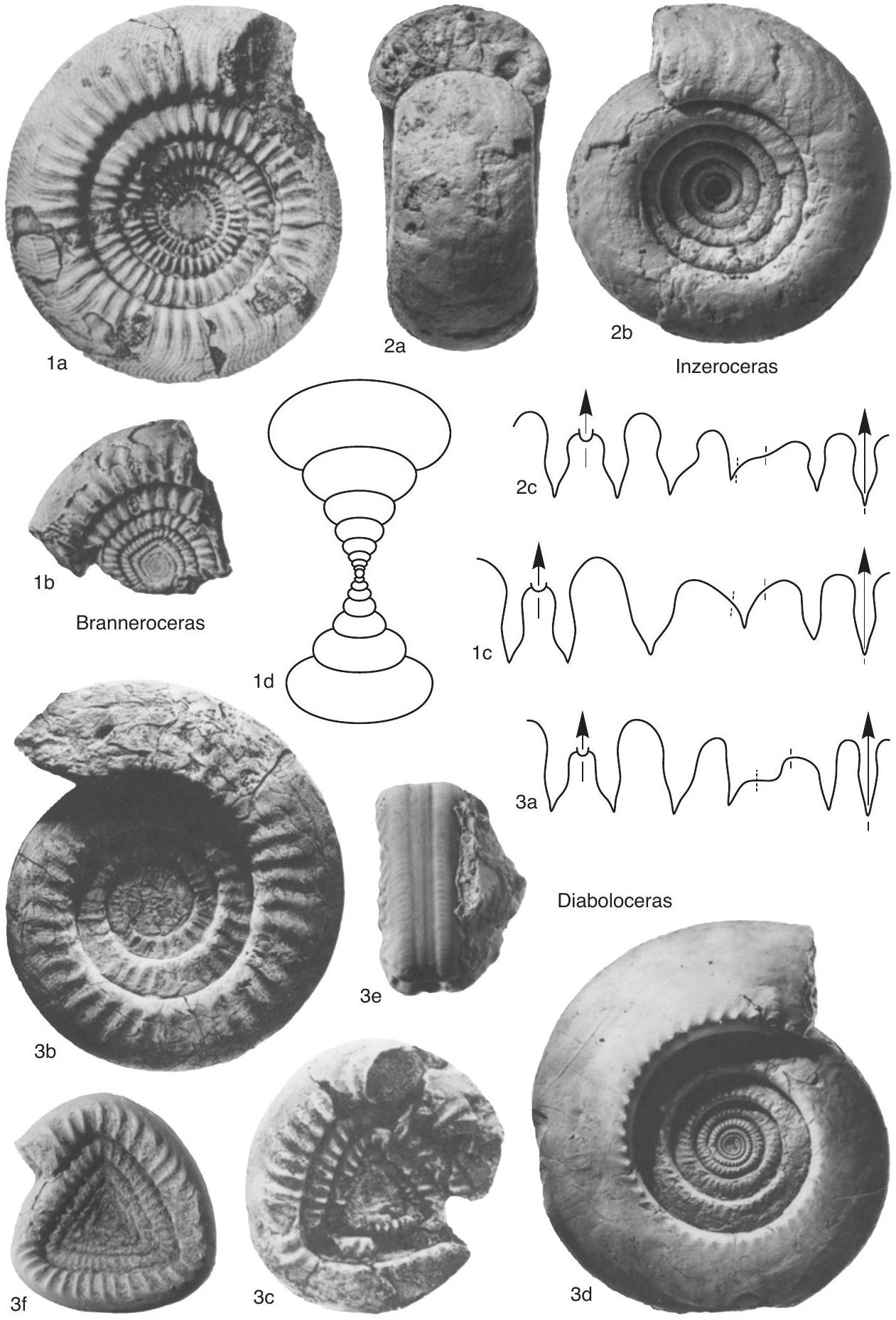Welcome to the Treatise on Invertebrate Paleontology!
Please enter a genera name to retrieve more information.

Branneroceras
Classification
Phylum:
Mollusca
Class:
Cephalopoda
Subclass:
Ammonoidea
Order:
Goniatitida
Suborder:
Goniatitina
Superfamily:
Schistoceratoidea
Family:
Schistoceratidae
Formal Genus Name and Reference:
Branneroceras Plummer & SCOTT, 1937, p. 218
Type Species:
Gastrioceras branneri SMITH, 1896, p. 257, OD
Images
(Click to enlarge in a new window)
Fig. 66, 1a-d. *B. branneri (Smith), a, side view, Brentwood Limestone Member, Bloyd Formation, 11 km southwest of Harrison, Boone County, Arkansas, SUI 11694, X 0.8, b, side view of fragment, limestone conglomerate of Brentwood Member, Devil's Den State Park on Lee Creek, about 12 km southwest of Winslow, Washington County, SUI 11693, X 1.9 (McCaleb, 1968), c, suture, SUI 1975, east side of Gaither Mountains, about 11 km southwest of Harrison, Boone County, Arkansas, X 1.5 (Miller & Moore, 1938), d, cross section, Morrowan, Arkansas, X 4.1 (Ruzhentsev, 1950).
Synonyms
Tschungkuoceras
Geographic Distribution
Spain, Ukraine (Donets), Algeria, China (Gansu, Guangxi, Guizhou, Xinjiang), Japan, Iran, Kyrgyzstan, Uzbekistan, Canada (Northwest Territories), USA (Arkansas, Oklahoma, Texas, Nevada)
Age Range
Beginning Stage in Treatise Usage:
Pennsylvanian (upper Bashkirian)
Beginning International Stage:
Bashkirian
Fraction Up In Beginning Stage:
0
Beginning Date:
323.4
Ending Stage in Treatise Usage:
Pennsylvanian (Moscovian)
Ending International Stage:
Moscovian
Fraction Up In Ending Stage:
100
Ending Date:
307.02
Description
Conch form evolute, with wide or moderately wide umbilicus. Coiling of inner whorls in some forms irregular to tetragonal. Ribs transversely elongate, fasciculating into several weak ribs, or dichotomizing on flanks or ventrolateral shoulder, with ventrolateral salient and deep ventral sinus. Growth striae biconvex, crossed by fine longitudinal lirae, producing crenulate appearance. Branches of ventral lobe narrow, height of median saddle about three-quarters entire ventral lobe.
References
Museum or Author Information
Classification
Phylum:
Mollusca
Class:
Cephalopoda
Subclass:
Ammonoidea
Order:
Goniatitida
Suborder:
Goniatitina
Superfamily:
Schistoceratoidea
Family:
Schistoceratidae
Formal Genus Name and Reference:
Branneroceras Plummer & SCOTT, 1937, p. 218
Type Species:
Gastrioceras branneri SMITH, 1896, p. 257, OD
Images
(Click to enlarge in a new window)
Fig. 66, 1a-d. *B. branneri (Smith), a, side view, Brentwood Limestone Member, Bloyd Formation, 11 km southwest of Harrison, Boone County, Arkansas, SUI 11694, X 0.8, b, side view of fragment, limestone conglomerate of Brentwood Member, Devil's Den State Park on Lee Creek, about 12 km southwest of Winslow, Washington County, SUI 11693, X 1.9 (McCaleb, 1968), c, suture, SUI 1975, east side of Gaither Mountains, about 11 km southwest of Harrison, Boone County, Arkansas, X 1.5 (Miller & Moore, 1938), d, cross section, Morrowan, Arkansas, X 4.1 (Ruzhentsev, 1950).
Synonyms
Tschungkuoceras
Geographic Distribution
Spain, Ukraine (Donets), Algeria, China (Gansu, Guangxi, Guizhou, Xinjiang), Japan, Iran, Kyrgyzstan, Uzbekistan, Canada (Northwest Territories), USA (Arkansas, Oklahoma, Texas, Nevada)
Age Range
Beginning Stage in Treatise Usage:
Pennsylvanian (upper Bashkirian)
Beginning International Stage:
Bashkirian
Fraction Up In Beginning Stage:
0
Beginning Date:
323.4
Ending Stage in Treatise Usage:
Pennsylvanian (Moscovian)
Ending International Stage:
Moscovian
Fraction Up In Ending Stage:
100
Ending Date:
307.02
Description
Conch form evolute, with wide or moderately wide umbilicus. Coiling of inner whorls in some forms irregular to tetragonal. Ribs transversely elongate, fasciculating into several weak ribs, or dichotomizing on flanks or ventrolateral shoulder, with ventrolateral salient and deep ventral sinus. Growth striae biconvex, crossed by fine longitudinal lirae, producing crenulate appearance. Branches of ventral lobe narrow, height of median saddle about three-quarters entire ventral lobe.
